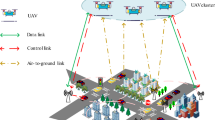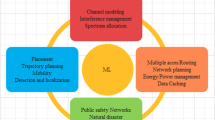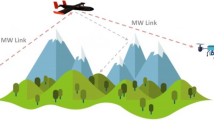Abstract
With the global standardization and deployment of the Internet of Things and wireless communication technologies along with rapid growth of applications (micro as well as macro) amongst these areas, unmanned aerial vehicles (UAVs) are appearing as swiftly emerging research hotspots. Moreover, in comparison with the ground oriented solutions, the adoption of UAVs is expected to rise exponentially taking their spectral efficiency and improved coverage into consideration. But certainly, there would be some issues related with this degree of freedom. In this context, the ensemble methods of advanced machine learning are expected to come to the rescue of already figured out problems related to the typical UAV communication. In the light of the same, this research paper addresses review of all the relevant research works in the application domain which utilizes various advanced ensemble techniques melded for the improvement of communication in UAV systems. Challenges and proposed solutions for the ensemble enabled UAVs are also addressed as a part of this work.

Similar content being viewed by others
Explore related subjects
Discover the latest articles, news and stories from top researchers in related subjects.References
Anderson K, Gaston KJ. Lightweight unmanned aerial vehicles will revolutionize spatial ecology. Front Ecol Environ. 2013;11(3):138–46.
Shakhatreh H, Sawalmeh AH, Al-Fuqaha A, Dou Z, Almaita E, Khalil I, Guizani M. Unmanned aerial vehicles (UAVs): a survey on civil applications and key research challenges. IEEE Access. 2019;7:48572–634.
Ardabili S, Mosavi A, Varkonyi-Koczy AR. Advances in machine learning modeling reviewing hybrid and ensemble methods. Cham: Springer; 2019.
El Badawi H, Azaïs F, Bernard S, Comte M, Kerzérho V, Lefevre F. Use of ensemble methods for indirect test of RF circuits: can it bring benefits?. In: 2019 IEEE Latin American Test Symposium (LATS); 2019. pp. 1–6. IEEE. https://doi.org/10.1109/LATW.2019.8704641.
Goudos SK, Athanasiadou G. Application of an ensemble method to UAV power modeling for cellular communications. IEEE Antennas Wirel Propag Lett. 2019;18(11):2340–4.
Goudos SK, Tsoulos GV, Athanasiadou G. Modelling received signal power in modern mobile communications with UAVs using ensemble learning. In: 2019 13th European Conference on Antennas and Propagation (EuCAP); 2019. pp. 1–4. IEEE.
Jung HS, Lee S. Special issue on machine learning techniques applied to geoscience information system and remote sensing. Appl Sci. 2019;9(12): 2446.
Hosseinalizadeh M, Kariminejad N, Chen W, Pourghasemi HR, Alinejad M, Behbahani AM, Tiefenbacher JP. Spatial modelling of gully headcuts using UAV data and four best-first decision classifier ensembles (BFTree, Bag-BFTree, RS-BFTree, and RF-BFTree). Geomorphology. 2019;329:184–93.
Goswami J, Sharma V, Chaudhury BU, Raju PLN. Rapid identification of abiotic stress (frost) in in-filed maize crop using UAV remote sensing. 2019. Int Arch Photogramm Remote Sens Spatial Inf Sci. https://doi.org/10.5194/isprs-archives-XLII-3-W6-467-2019.
Jónsson S. (2019) RGB and Multispectral UAV image classification of agricultural fields using a machine learning algorithm. Student thesis series INES.
Boubin J, Chumley J, Stewart C, Khanal S. Autonomic computing challenges in fully autonomous precision agriculture. In: 2019 IEEE International Conference on Autonomic Computing (ICAC). 2019. pp. 11–7. IEEE. https://doi.org/10.1109/ICAC.2019.00012.
Laamrani A, Berg AA, Voroney P, Feilhauer H, Blackburn L, March M, Martin RC. Ensemble identification of spectral bands related to soil organic carbon levels over an agricultural field in Southern Ontario, Canada. Remote Sensing. 2019;11(11):1298.
Aboutalebi M, Allen LN, Torres-Rua AF, McKee M, Coopmans C. Estimation of soil moisture at different soil levels using machine learning techniques and unmanned aerial vehicle (UAV) multispectral imagery. In: Autonomous Air and Ground Sensing Systems for Agricultural Optimization and Phenotyping IV Vol. 11008. International Society for Optics and Photonics; 2019. p. 110080S.
Zhang Y, Wen J, Yang G, He Z, Luo X. Air-to-air path loss prediction based on machine learning methods in urban environments. Wirel Commun Mobile Comput. 2018. https://doi.org/10.1155/2018/8489326.
Yang G, Zhang Y, He Z, Wen J, Ji Z, Li Y. Machine-learning-based prediction methods for path loss and delay spread in air-to-ground millimetre-wave channels. IET Microw Antennas Propag. 2019. 13(8):1113–21.
Shoufan A, Al-Angari HM, Sheikh MFA, Damiani E. Drone pilot identification by classifying radio-control signals. IEEE Trans Inf Forensics Secur. 2018;13(10):2439–47.
Sciancalepore S, Ibrahim OA, Oligeri G, Di Pietro R. Detecting drones status via encrypted traffic analysis. In: Proceedings of the ACM workshop on wireless security and machine learning. ACM; 2019. pp. 67–72. https://doi.org/10.1145/3324921.3328791.
Dabas C. Recent research on data analytics techniques for internet of things. In: Singh M, Gupta P, Tyagi V, Flusser J, Ören T, Kashyap R, editors. Advances in computing and data sciences. ICACDS 2019. Communications in computer and information science, vol. 1045. Singapore: Springer; 2019;20(7):4205–4220
Zeng Y, Xu X, Jin S, Zhang R (2021) Simultaneous navigation and radio mapping for cellular-connected UAV with deep reinforcement learning. IEEE Trans Wireless Commun.
Lim WYB, Huang J, Xiong Z, Kang J, Niyato D, Hua XS et al. Towards federated learning in uav-enabled internet of vehicles: a multi-dimensional contract-matching approach. IEEE Trans Intell Transp Syst. 2021;22(8):5140–45.
Granados-Bolaños S, Quesada-Román A, Alvarado GE. Low-cost UAV applications in dynamic tropical volcanic landforms. J Volcanol Geothermal Res. 2021;410: 107143.
Nemer I, Sheltami T, Ahmad I, Yasar AUH, Abdeen MA. RF-based UAV detection and identification using hierarchical learning approach. Sensors. 2021;21(6):1947.
Boonpook W, Tan Y, Xu B. Deep learning-based multi-feature semantic segmentation in building extraction from images of UAV photogrammetry. Int J Remote Sens. 2021;42(1):1–19.
Feng L, Zhang Z, Ma Y, Du Q, Williams P, Drewry J, Luck B. Alfalfa yield prediction using UAV-based hyperspectral imagery and ensemble learning. Remote Sens. 2020;12(12):2028.
Author information
Authors and Affiliations
Corresponding author
Ethics declarations
Conflict of Interest
The author declares that she has no conflict of interest.
Ethical Approval
This article does not contain any studies with human participants performed by any of the authors.
Additional information
Publisher's Note
Springer Nature remains neutral with regard to jurisdictional claims in published maps and institutional affiliations.
This article is part of the topical collection “Advanced Computing and Data Sciences” guest edited by Mayank Singh, Vipin Tyagi and P.K. Gupta.
Rights and permissions
About this article
Cite this article
Dabas, C. Insight of Unmanned Aerial Vehicles Accessing Ensemble Techniques. SN COMPUT. SCI. 2, 458 (2021). https://doi.org/10.1007/s42979-021-00842-y
Received:
Accepted:
Published:
DOI: https://doi.org/10.1007/s42979-021-00842-y




